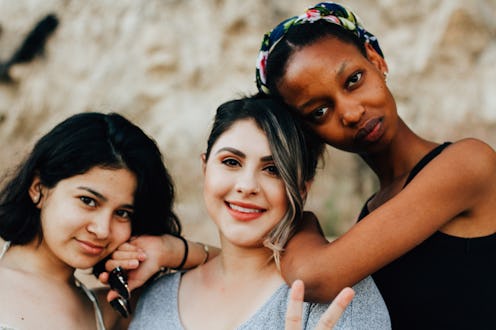
Feminism can't help all the oppressed groups who need it if we don't practice it through an intersectional lens. But what exactly is intersectional feminism, and why does intersectionality matter? Although there's no denying that there are plenty of trolls on Twitter, it's also full of intersectional feminists — and in their tweets, these eight Twitter users not only define some of the key tenets of intersectionality, but also explain why it's so important to practice, too. As Flavia Dzodan now famously wrote, "My feminism will be intersectional or it will be b*llsh*t."
First, though, a brief background on the term. Scholar and civil rights activist Kimberlé Williams Crenshaw coined it in the 1989 essay “Demarginalizing the Intersection of Race and Sex: A Black Feminist Critique of Antidiscrimination Doctrine, Feminist Theory and Antiracist Politics.” In the piece, she compared oppression to a traffic intersection with cars moving every which way. "If an accident happens in an intersection, it can be caused by cars traveling from any number of directions and, sometimes, from all of them," she wrote. "Similarly, if a Black woman is harmed because she is in an intersection, her injury could result from sex discrimination or race discrimination."
Google also offers a more colloquial definition of intersectionality you might encounter on a more regular basis: "The interconnected nature of social categorizations such as race, class, and gender as they apply to a given individual or group, regarded as creating overlapping and interdependent systems of discrimination or disadvantage." So, practicing intersectional feminism means acknowledging that you can't just think about gender because different groups experience gender differently. For example, different cultures may have different definitions of femininity and masculinity.
Furthermore, being an intersectional feminist means acknowledging that people who are members of multiple oppressed groups experience multiple types of oppression and oppression specific to being a member of those intersecting groups. For instance, as Kimberlé Williams Crenshaw noted, black women face discrimination for being black, for being women, and for being black women.
These people explained it better than I could, though. Here are a few key principles of intersectionality as detailed by some of Twitter's badass intersectional feminists.
1. Intersectional Feminism Is The Opposite Of White Feminism
Before understanding what intersectional feminism is, it's helpful to understand what it's not. White feminism — a form of feminism that privileges issues relevant to white women — is the antithesis of intersectional feminism. White feminists (that is, feminists who practice white feminism, not feminists who are white) only consider how the most privileged women might be affected by certain issues, and they often ignore or even dismiss the concerns of women of color, women with disabilities, and others who are oppressed for reasons beyond their gender. Intersectional feminism seeks to instead include these groups in a movement from which they've historically been excluded.
2. Many, Many Groups Need Attention
Intersectional feminism is often discussed in the context of race, but it's also important to consider a number of other issues, with size, disability, age, sexuality, and class being a few. It's also important to note that feminism isn't just for women: It's also for men, for gender-nonconforming people — for everyone.
3. It's About Respecting Other Cultures
One problem with white feminism is that it often looks down on other cultures. For example, some white feminists criticize women who wear hijabs under the assumption that their choice of clothing is oppressive. Intersectional feminism requires respecting people of other cultures and religions even if their feminism doesn't look like yours.
4. It Means Examining Your Own Intersecting Identities
Being an intersectional feminist is not just about abstract ideals. It's also about examining how intersectionality manifests in our own lives, both when we're oppressed and when we're privileged. It might mean, for example, looking at how being a cisgender woman gives you a privileged position in feminism or how being white has afforded you unfair advantages within the LGBTQ movement.
5. Many Women Have It Worse Than Others
Feminists often talk about the pay gap and other statistics that compare all women to all men. But when we look at race, class, disability, and other factors, it becomes clear that looking at women in the aggregate doesn't tell the whole story. The wage gap, for example, is far higher for black and Latina women, because racial inequality is still a huge problem in the United States.
6. Privileged People Are Not The Authority...
Yes. This.
7. ... Which Means Sometimes Being Quiet
Even if you experience oppression because you are a woman, you still may have it a lot easier than other women and gender minorities and even some men. This means that sometimes, you need to take a back seat and listen to other people's experiences rather than trying to explain their own oppression (or supposed lack thereof) to them. The job of white people, men, and other privileged groups in any social justice movement, including intersectional feminism, is not to decide what is good or bad for marginalized groups, but to listen.
8. The Ultimate Goal Is To Make Everyone Feel Included
Why do we practice intersectionality in feminism? Simple: Because the goal of feminism is equality for all people, not just a select few. And when we pretend that oppression can be adequately described simply by comparing women to men, we gloss over a lot of issues that are pertinent to a lot of people.
Images: Unsplash; all tweets used with permission of their users.